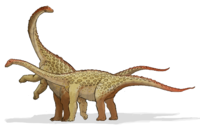Saltasaurus
2007 Schools Wikipedia Selection. Related subjects: Dinosaurs
| iSaltasaurus |
||||||||||||||||||||
|---|---|---|---|---|---|---|---|---|---|---|---|---|---|---|---|---|---|---|---|---|
 |
||||||||||||||||||||
|
|
||||||||||||||||||||
|
Extinct (fossil)
|
||||||||||||||||||||
| Scientific classification | ||||||||||||||||||||
|
||||||||||||||||||||
|
|
||||||||||||||||||||
| Saltasaurus loricatus Bonaparte & Powell, 1980 |
Saltasaurus (which means "lizard from Salta") was a sauropod dinosaur of the Late Cretaceous Period. Relatively small among sauropods, though still massive by human standards, it was characterized by a diplodocid-like head (with blunt teeth, only in the back of the mouth) and was the first discovered with small bony plates embedded in its skin. The bony plates (a form of armour called osteoderms) have since been found in other titanosaurids, and a crest of scutes has also been discovered, running down the back of diplodocids. When the plates of a saltosaur were originally found, independently of skeletal remains, they were assumed to be from an ankylosaurian, whose plates they resemble.
The word "Saltasaurus" is occasionally spelled "Saltosaurus", even by palaeontologists. The Saltasaurus may also be confused with Saltopus, because of the similarity between their names, although the two genera are quite unlike one another.
Fact summary
Saltasaurus was first described by José Bonaparte and Jaime E. Powell, in 1980 and had an estimated length of 12 metres (39 feet) and a mass of 7 tonnes (8 tons). Like all sauropods, Saltasaurus was purely herbivorous and is thought to have been able to rear up on its hind legs, to reach higher branches. The name "Saltasaurus" is taken from the region of north-west Argentina, where the first fossils were recovered. Other fossils have since been found in Uruguay.
There is currently only one known species of Saltasaurus, S. loricatus. S. robustus is no longer considered a distinct species, and S. australis is now considered to be a separate genus, the Neuquensaurus. The fossils of Saltasaurus include vertebrae, limb bones and several jaw bones — plus various pieces of armour. Some of these plates appear to have spikes as well, but there is not enough evidence available to be certain.
Changing perceptions
In the Cretaceous Period, sauropod dinosaurs in North America were losing the survival game to duck-billed dinosaurs, such as Edmontosaurus. However, like modern Australia, South America was an island continent and life evolved rather differently there. Specifically, the duck-billed dinosaurs never gained a foothold and so sauropods, specifically the titanosaurids, continued down their own path of evolution. (See also: allopatric speciation.)
Saltasaurus was one such highly-evolved sauropod and lived 70 to 65 million years ago. When it was first discovered, in 1980, it forced palaeontologists to reconsider many of their assumptions about what was and what was not a sauropod because Saltasaurus, although clearly a sauropod, had armour plating. Previously, it had been assumed that size alone was sufficient defence for the massive sauropods.
However, a Saltasaurus was discovered covered with bony knobs, 10 to 12 centimetres (4 to 5 inches) in diameter. Since then, palaeontologists have investigated the possibility that other sauropods may also have had armour; for example, the Argentinian Laplatasaurus.
Eggs?
A large titanosaur nesting ground was discovered in 1997, by Luis Chiappe and his team, near Auca Mahuevo, in Patagonia, Argentina. The small eggs, about 11 to 12 centimetres (4 to 5 inches) in diameter, contained fossilised embryos, complete with skin impressions (although there was no indication of feathers or dermal spines). These eggs may have belonged to Saltasaurus.
Apparently several hundred females dug holes, laid their eggs and then buried them under dirt and vegetation. This gives evidence of herd behaviour, which, along with their armour, may have been a defence against large predators like the Abelisaurus.